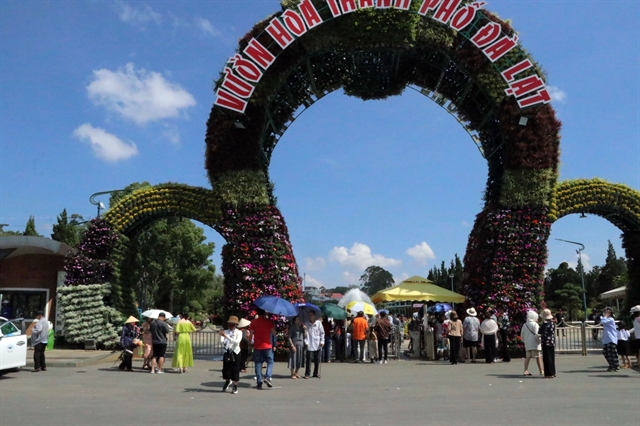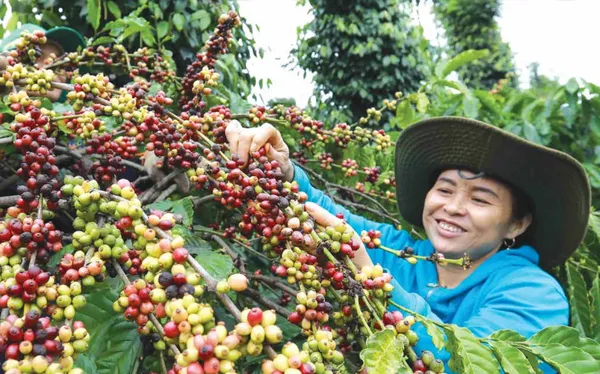 Society
Society

 |
| Đà Lạt's City Garden, a famous destination in the city. A preliminary report from the authorities in Đà Lạt city indicates that during the recent five-day holiday period, Đà Lạt welcomed 170,000 visitors. — VNA/VNS Photo Quốc Hùng |
ĐÀ LẠT — Famous for its cool climate, Đà Lạt is the choice of many for vacations, especially during hot seasons. However, this year, tourists were disappointed to find that the "city of thousands of flowers" was warmer.
"I noticed changes when I visited Đà Lạt during Tết (Lunar New Year), but this time it feels even warmer. Of course, compared to other places, it's still quite okay, but compared to Đà Lạt itself in the past, the climate has warmed up significantly. According to weather apps on my phone, the outdoor temperature reached 31–32 degree Celsius," said Nguyễn Thị Hương, a tourist who visited Đà Lạt during the recent holidays.
"With this trend, in a few years, Đà Lạt might be hotter like other places," Hương added.
Nguyễn Văn Bình, a resident of Đà Lạt, explained that since Tết (Lunar New Year), the weather in Đà Lạt has been experiencing four seasons in one day. This period starts from after Tết until the beginning of summer.
During midday, from 10am to around 2pm, there is hot sunshine, with the peak from 11am to 1pm. After that, the weather becomes cool again, and the evenings are chilly, requiring warm clothing.
However Bình still believes that Đà Lạt remains a cool and ideal destination, despite the reality that the temperature there has indeed increased.
"Previously, the highest temperature was only 25–26 degree Celsius, but in recent years, historical temperatures of 30 - 31 degree Celsius have appeared, albeit for a very short time, just one to two hours during midday. The cause is global climate change, not something unique to Đà Lạt," said Bình.
Comparing the weather records during the recent two holiday periods reveal a notable rise in temperatures at several resort destinations.
Specifically, in Đà Lạt in 2023, the temperature fluctuated between 14 and 27 degree Celsius, while this year it ranged from 16 to 29°C, indicating an average increase of 2 degree Celsius. Similarly, in Măng Đen Town (Kon Plông District, Kon Tum Province), the temperature in 2023 ranged from 18 to 31 degree Celsius, whereas this year it varied from 20 to 32 degree Celsius, marking an increase of one to 2 degree Celsius.
In the renowned tourist destination of Sa Pa, the holiday temperatures in 2023 ranged from 13 to 23 degree Celsius, whereas this year, the lowest recorded temperature was 20 degree Celsius and the highest was 24 degree Celsius. The lowest temperature observed experienced a significant increase of 7 degree Celsius, while the highest saw a slight rise of 1 degree Celsius.
Overall, the trend indicates a warming climate, prompting many individuals to seek cooler locales. There is a prevailing sense that places traditionally known for their cool temperatures throughout the year are gradually becoming warmer.
Restoring a natural way of living
According to Lê Anh Tuấn, former Deputy Director of the Research Institute for Climate Change (Cần Thơ University), Việt Nam in 2024 is witnessing exceptionally hot weather. One of the direct factors contributing to this phenomenon is the residual impact of El Niño, although it is currently weak. The heatwave is affecting not only Southeast Asia but also many other areas across Asia. Additionally, the accumulation of greenhouse gas emissions is causing the Earth's temperature to rise steadily each year. This trend is most evident in equatorial and near-equatorial regions. As a country situated near the equator, Việt Nam is significantly affected by these changes.
"Compared to many other cool climate tourist destinations in Việt Nam, Đà Lạt is experiencing a notable impact, and we can see that this destination is no longer as cool as before," remarked Tuấn, attributing this change to both natural factors and the city's self-warming tendencies.
It's evident that a substantial portion of the pine forest has been lost compared to the past, with increased urbanisation taking its place. Another observable issue is the proliferation of greenhouses for growing vegetables and flowers. While these farms contribute to economic development, they replace greenery and the greenhouses themselves contribute to increasing surface temperatures.
"This is similar to why Hồ Chí Minh City, despite not having the highest meteorological temperatures, always feels very hot to its residents, with a perceived high temperature," explained Tuấn.
In summary, Tuấn concluded that urban planning in Việt Nam has focused too much on economic factors in recent years, neglecting environmental and climatic concerns. For example, when it's necessary to fell trees to build roads, we are always ready to compromise without considering alternative solutions. However, in climate science, there is the concept of "urban heat islands", meaning the climate at specific locations. If a city doesn't pay attention to this factor and overcrowds it with tall buildings, it will generate a large amount of heat. This heat is trapped by the skyscrapers, making the residents living there feel hotter than elsewhere. It's challenging to address these issues in Việt Nam because our urban planning has long been focused on centralized development rather than satellite-based development.
Tuấn recommends that Đà Lạt needs to restore the pine forest area in the city centre and the natural waterfall systems surrounding it. Furthermore, reducing the number of greenhouses for growing vegetables and flowers within the city is essential. Organising and relocating tourist spots away from the city center and establishing satellite attractions connected by a well-developed transportation system are also crucial.
Many countries are now trending towards not developing green parks within cities anymore but instead creating "forest cities," or more accurately, planting forests within cities. They cultivate and nurture various types of trees that can grow into old trees, natural water bodies... to create natural buffer zones for urban areas. With its relatively good natural conditions, Tuấn suggested that Đà Lạt also needs to adopt a similar plan following the natural-friendly trend of "forest cities". VNS









